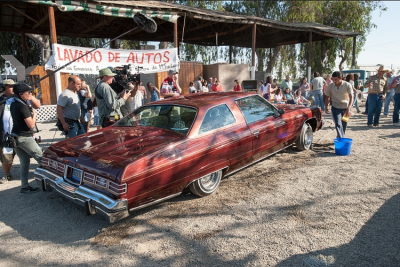When it came time to tell the story of “McFarland, USA”, New Zealander Niki Caro immersed herself in the culture and community of McFarland, California. Initially inspired by former McFarland cross-country coach Jim White and the 1987 McFarland team and the legacy they created, what really drew Caro to direct the project was that “I was really inspired by the people, by how hard they work, by the commitment to their families, their faith, their community. And it was great for me to be able to light that up.” Describing the experience as “deeply satisfying . . .to go in and tell a story that is not only meaningful, but is true and real, and tell it with the real people”, Caro attributes her intimate telling of “McFarland, USA” to her filmmaking philosophy: “[G]oing there and observing. Eyes, ears, heart open. Mouth shut. I can only speak for myself as a filmmaker, [but] it would be arrogant and stupid to assume that I know better than those guys what their life is like. It makes it very easy for me as a filmmaker to go and observe what life is like. THEN I bring my skill in to express that in a way that hopefully an audience can appreciate it in the same way that I do.”
And while Caro was committed to the community and the truth of the McFarland story, there was one element of the film not initially included which Caro was passionate about bringing into the mix. Lowriders. Cars custom-fitted with hydraulic jacks that allow chassis to be lowered as close to the pavement as possible, during the 1980’s in California’s Central Valley, lowriders and “lowriding” was an important element of the culture of the time. Noting that “I wouldn’t have put them in the movie [if not authentic] – and I did – the low riding elements of the movie did not exist before I came in. Low riding is kind of a big part of my life because my husband’s very big into that world and we’ve always had those cars. I wouldn’t have brought that to this movie if it hadn’t been very authentic to that place. The Central Valley? Bakersfield? Very big low riding. Particularly in the 80’s.”
Even non-lowriding afficionados will note the beauty and elegance of the lowriders but, more than that, the ethic of the lowriding community. It’s all about family. And “family” is just what the car clubs Caro reached out to for help with the film are all about.
“One of the first people I ever met was Harvey Reyes. His car club up there is called Carnales Unidos, so way before I started working on this script – actually the same time I went to visit Jim White for the first time – I went and visited Harvey and his wife Gloria. Gloria remains a very good friend. My husband, who is kind of all about it, and all about getting it right, he sourced the cars. The cars are so authentic and so specific. We could have used sexier cars but the sexier cars weren’t there [in 1987]. So those cars actually came from a car club in North Hollywood – The Glass House. Harvey’s car in the movie with the mural on the hood, that’s now mine. So that’s what I drive my kids to school in.”
Describing the inclusion of the lowriders as “a nice, glamorous colorful element in the movie”, for Caro, the meaning goes ever deeper. “It was for me, important to make the point that low riding in Hollywood movies is usually shorthand for gangster. My experience, and I’ve had a bit, probably more experience than a white, middle class, mother of two from Auckland, New Zealand should probably have, is that car clubs – all those guys – are all about family, they’re all about community.”
Hear Niki Caro’s passion for lowriders in this excerpt of our exclusive interview













